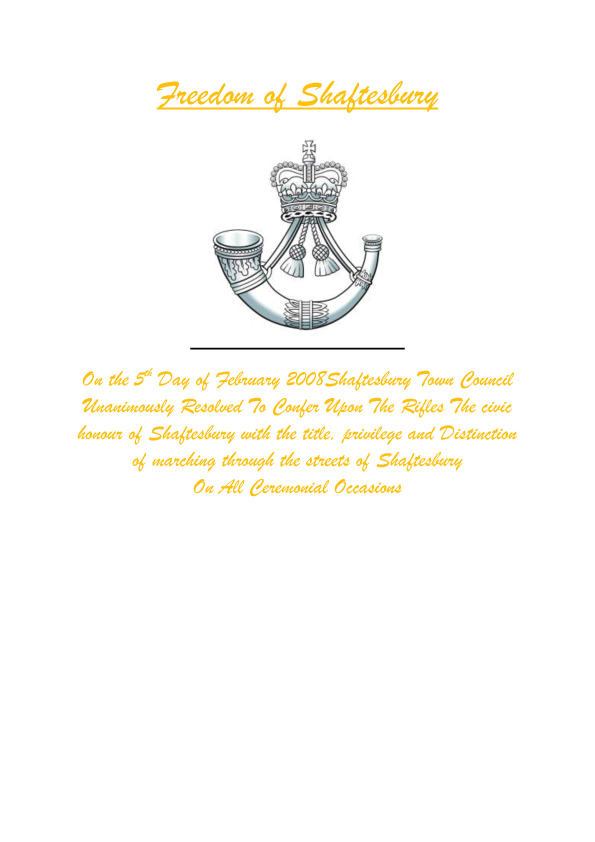Dorset Regimental History 1689 – Until Today
39th (Dorsetshire) Regiment of Foot
In March 1689, the recently deposed James II landed in Ireland intent on retaking the throne from his son-in-law, William III. That month, the Welsh nobleman John Vaughan raised a regiment in Ireland to oppose James’s army. In gratitude, William later made him an Irish peer as Viscount Lisburne.
In 1692, the regiment’s colonelcy transferred to Richard Coote. Although the unit disbanded in 1697, Coote raised a new regiment in 1702, often regarded as the previous unit’s successor. This remained in Ireland for five years before being sent to fight in Spain and Portugal during the War of the Spanish Succession (1701–14)
This infantry regiment was raised in 1659. It continued in the British Army service until the 1881 reforms, when it was amalgamated with the 54th (West Norfolk) Regiment of Foot to form The Dorsetshire Regiment.
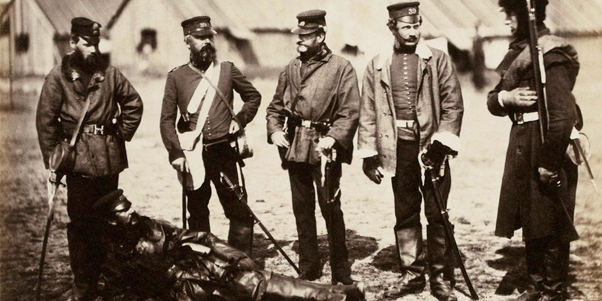 Lieutenant-Colonel Munro and officers of the 39th (Dorsetshire) Regiment in the Crimea, 1855
Lieutenant-Colonel Munro and officers of the 39th (Dorsetshire) Regiment in the Crimea, 1855
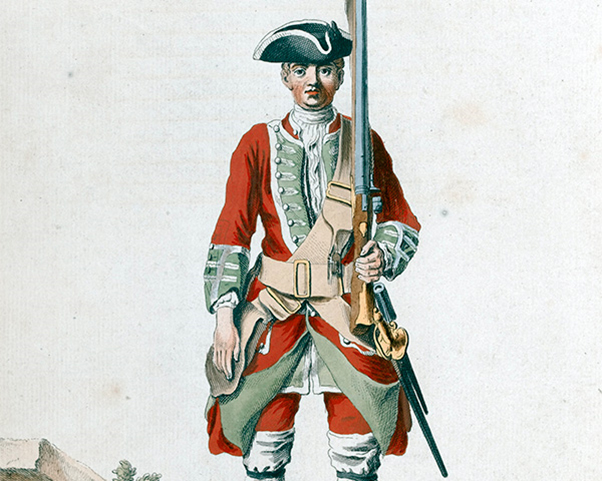 A Soldier of the 39th of Foot, 1742
A Soldier of the 39th of Foot, 1742
18th century
In 1713, the regiment was sent to garrison the new colony of Minorca, ceded to Britain under the terms of the Treaty of Utrecht. It remained in the Mediterranean serving as infantry and marines until 1719. It would serve as marines again in 1744, this time in the North Sea, during the War of the Austrian Succession (1740-48).
In 1726-27, it helped withstand the siege of Gibraltar, another territory that had been ceded to Britain by Spain in 1713. It would return there for the Great Siege (1779-83) – the only regiment to serve in both campaigns - after which it was allowed to add Gibraltar’s castle and key to its badge.
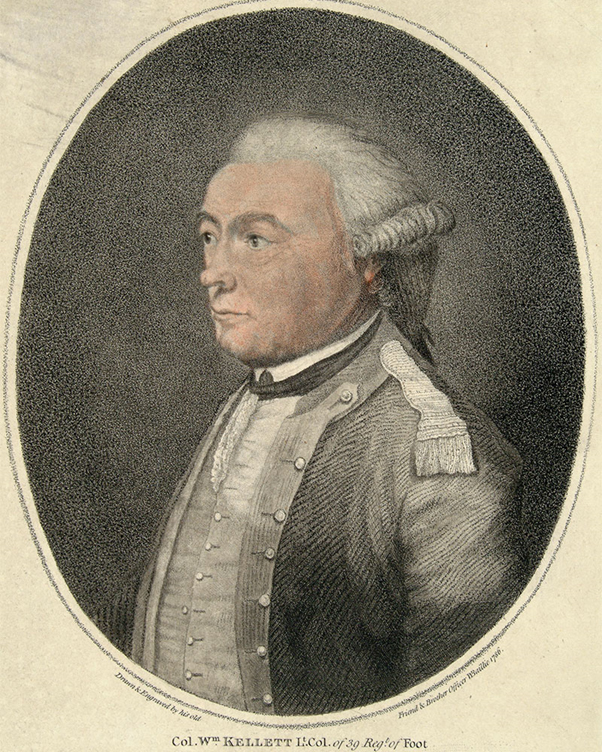 Colonel William Kellett, 39th Regiment of Foot, c1786
Colonel William Kellett, 39th Regiment of Foot, c1786
It went to Jamaica on its first West Indian posting in 1730. The regiment also returned to Ireland frequently during its initial 50 years.
The regiment was given the number 39 in the line infantry order of precedence in 1751. A county affiliation with East Middlesex would follow in 1782.
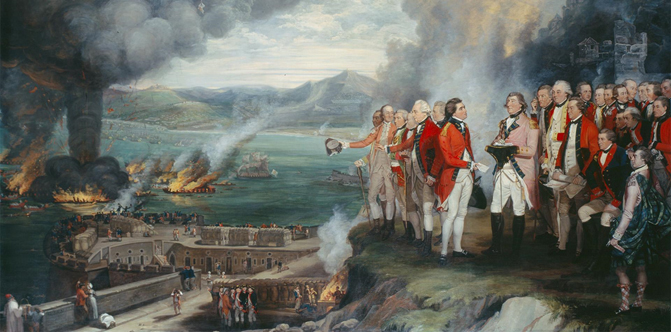
The destruction of the Floating Batteries, Gibraltar, 14 September 1782 (Lieutenant-Colonel William Kellett of the 39th Foot stands third from the left)
In 1754, the 39th Foot became the first British Army unit to be deployed to India, earning it the motto ‘Primus in Indis’ (‘First in India’). The 54th Foot was raised in 1755. It fought there in the Seven Years War (1756-63), including at Plassey (1757), for which it received a battle honour - the only British Army unit to do so.
Later, the 39th was one of the four British Infantry regiments to serve throughout the great siege of Gibraltar (1779 – 83) and was the only one to serve also in the previous siege of 1727.
The Dorset Yeomanry was first raised on 9 May 1794 as the Dorsetshire Regiment of Volunteer Yeomanry Cavalry of six troops. In 1796, it became the Dorsetshire Rangers and now consisted of ten troops. In 1802, it was disbanded as a result of the Treaty of Amiens and the consequent peace.
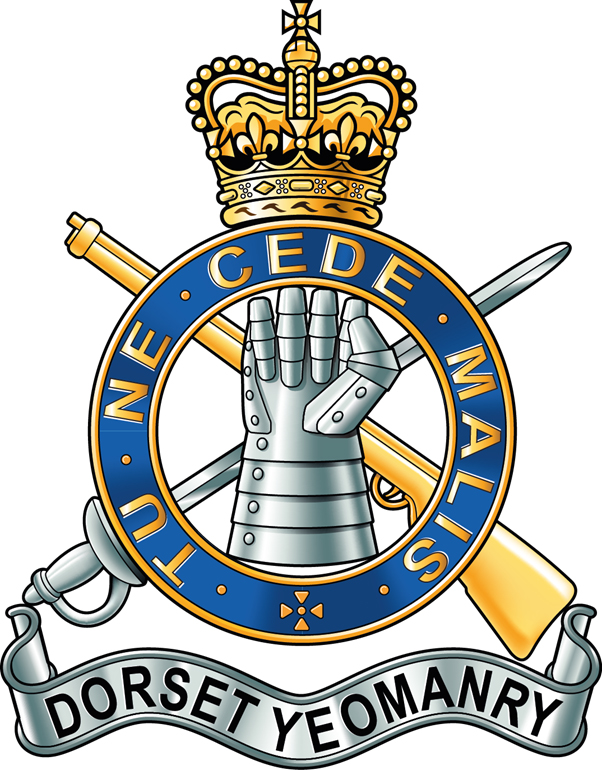

A Short History of the Dorset Yeomanry
The history of the Yeomanry of Dorset begins with the formation of a mounted volunteer corps of ‘Gentry and Tenant Farmers’ of the County in 1784. The Dorset Volunteer Rangers were first commanded by Lord Milton of Milton Abbas.
Once the threat of the French Revolutionary Wars receded in 1802 the regiment disbanded later reformed as the Dorset Volunteer Cavalry when Napoleon Bonaparte threatened invasion in 1804. Napoleon’s abdication in 1814 saw the Regiment stood down again. Independent troops were retained by some landowners and were used on occasions to supress civil unrest in the County. The Regiment was re-raised in 1830 largely for this purpose, there being no Dorset Constabulary until 1855.
In 1843 the Yeomanry of Dorset acquired the title of The Queen’s Own Regiment of Yeomanry Cavalry after providing an escort to the Queen Dowager, Adelaide on an official visit to Dorset in that year. The QODY participated fully in the activities of the Yeomanry in the late 19th Century winning the Lloyd-Lindsay Cup, a national military skills competition on no less than four occasions.
The Second Boer War, 1899-1902 saw the first call for the Yeomanry to serve overseas. Dorset Yeoman responded forming the 26th (Dorset) Company of the 7th Battalion, Imperial Yeomanry serving with credit sadly losing 10 Yeomen whilst doing so. The QODY was, with all 55 Yeomanry Regiments drawn into the territorial Force on its creation in 1908 and placed in the 1st South Western Brigade at the outbreak of the Great War in August 1914. The QODY were embodied very quickly and efficiently with both men and horses. The QODY were deployed to Norfolk as part of the 2 nd South Midland Brigade with whom they would fight for much of the War. In April 1915 the Regiment was deployed to Egypt on mounted duties until August 17th/18th 1915 when the Brigade, including 377 men of the QODY landed at Suvla Bay in Gallipoli to fight as infantry. On August 21st at Scimitar Hill 45 Yeomen of Dorset were posted Killed or Missing in the worst single day of the War for the QODY. At the end of October 1915, the QODY returned to Egypt and their horses to the mounted role for the remainder of the Great War. The Regiment’s charge at Agagia on 26th February 1916 is still A Squadron’s ‘special day’ also commemorated by Lady Butler whose painting can be seen at The Keep in Dorchester.
The Regiment again famously charged at El Mughar with the other Regiments of their Brigade in November 1917 and were still serving as mounted troops at the Armistice of 1918 unlike many other Yeomanry Regiments who had been converted to infantry during the War. Following a quiet and unassuming homecoming the Regiment returned to Dorset less 208 of their number who fell during the Great War. Their distinguished service as mounted troops did not save the QODY in the huge post-war reorganisation and the Regiment converted to Field Artillery in 1922.
It was as artillery that the Yeomen of Dorset served during the Second World War. 141st (QODY) Field Regiment RA TA had the peculiar distinction of never leaving home shores. The same could not be said of the 94th (Dorset and Hants) Field Regiment RA TA who supported 43rd (Wessex) Division throughout the North West European Campaign from June 1944 to the defeat of Nazi Germany. Individual Yeomen were deployed to the Far East but not as a regiment.
The QODY remained as artillery until 1967 when they were merged into various local TA/Militia units until little remained of the old Regiment and its history. Until 1997.
In 1997 the Dorset Yeomanry was raised as the Army’s specialised Armoured Delivery Regiment. Although having no direct lineage to the old QODY the new Yeomen of Dorset were permitted to ‘realigned’ themselves with the history of Yeomanry in Dorset, something the new Regiment did with passion. A (DY) Squadron, RWxY maintains those traditions to this day.
Battalions of the Regular Army
1st Battalion
August 1914 : in Belfast. Part of 15th Brigade in 5th Division.
Landed at Le Havre 16 August 1914.
31 December 1915 : transferred to 95th Brigade in 32nd Division.
7 January 1916 : transferred to 14th Brigade in same Division.
1919: moved to Ebrington Barracks, Londonderry.
2nd Battalion
August 1914 : in Poona, India. Part of 16th Indian Brigade in Poona Division.
6 November 1914 : landed in Fao, Persian Gulf, for campaign in Mesopotamia, as part of Indian Expeditionary Force ‘D’.
3rd (Reserve) Battalion
August 1914 : in Dorchester. A depot/training unit, it remained in UK throughout the war.
Moved on mobilisation to Weymouth and in June 1915 went on to Wyke Regis for a role with the Portland garrison.
Battalions of the Territorial Force
1/4th Battalion
August 1914 : in Dorchester. Part of South Western Brigade in Wessex Division. Moved to Salisbury Plain.
9 October 1914 : sailed for India, landing Bombay 10 November 1914.
23 February 1916 : landed at Basra with 42nd Indian Brigade and remained in Mesopotamia for
the rest of the war.
2/4th Battalion
Formed at Dorchester in September 1914. Became part of 2nd South Western Brigade in 2nd Wessex Division. Moved to billets in Dorchester in October
5th (Service) Battalion
Formed at Dorchester in August 1914 as part of K1 and moved to Belton Park (Grantham), initially attached as Army Troops to 11th (Northern) Division.er 1914. 12 December 1914 : sailed for India.
6th (Service) Battalion
Formed at Dorchester on 6 September 1914 as part of K2. Moved to Wareham and initially attached as Army Troops to 17th (Northern) Division.
March 1915 : transferred to 50th Brigade in same Division. Moved to Romsey in May 1915.
Landed at Boulogne on 14 July 1915.
7th (Reserve) Battalion
Formed in Weymouth in November 1914 as a Service battalion, part of K4. Came under command of 102nd Brigade, original 34th Division.
10 April 1915 : converted into a Reserve Battalion. Moved to Wool in May 1915 and in July went on to Wareham (although some men’s records say Bovington) before returning to Wool in October.
1 September 1916 : converted into 35th Training Reserve Battalion of 8th Reserve Brigade.
Battalions of the New Armies
8 January 1915 : transferred to 34th Brigade in same Division.
Sailed from Liverpool on 3 July 1915, going via Mudros to land at Suvla Bay on 6 August 1915.
16 December 1915 : evacuated from Gallipoli and went to Egypt via Mudros.
Moved to France, arriving Marseilles 9 July 1916.
3/4th Battalion
Formed at Bath in April 1915 and moved to Cheddar. Moved on to Bournemouth in autumn 1915 and on to Romsey in spring 1916.
April 1916 : became Reserve Battalion.
In October 1916 it moved to Bournemouth, went on to Sutton Veny in February 1917 and Larkill in October 1917. Finally moved to Londonderry in April 1918.
1st (Home Service) Garrison Battalion
Formed in Wyke Regis in June 1916. Moved to Weymouth in August 1916 and on to Portland in November 1916. Disbanded January 1917.
8th (Home Service) Battalion
Formed in Wool on 1 September 1916 as the 2nd (Home Service) Garrison Bn.
Renamed 1 November 1916 after moving to Portland.
Came under command of 219th Brigade in 73rd Division and moved to Blackpool.
Moved to Danbury (Essex) in January 1917 and remained there until disbanded by 3 December 1917.
15 August 1917 left Bombay for Egypt, landing at Suez on 29 August.
13 December 1917 : came under command of 234th Brigade in 75th Division.
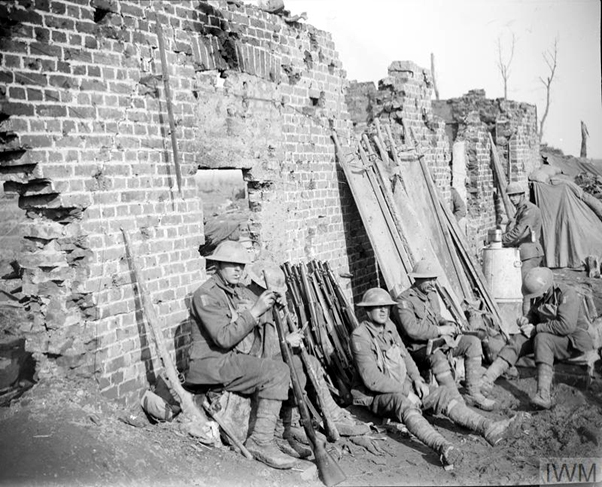 Troops of the Dorsetshire Regiment resting and cleaning rifles in the ruins of a farm near Langemarck, 17 October 1917. Copyright: © IWM. Original Source.
Troops of the Dorsetshire Regiment resting and cleaning rifles in the ruins of a farm near Langemarck, 17 October 1917. Copyright: © IWM. Original Source.
Moved to 233rd Brigade in same Division on 2 May 1918. August 1918 : disbanded in Egypt.
9th Battalion
Formed at Aldeburgh on 1 June 1918 but absorbed into the 6th Battalion of the Wiltshire Regiment on 18 June.
Regimental Depot Dorchester
Early 1919: HQ moves to Portsmouth but a detachment remains at Wyke.
March 1919: moved to Londonderry and absorbed the 4th Reserve Battaion.
Formation of the English Composite Battalion
29 April 1916 : Bn captured at Kut-el-Amara. During the siege at Kut, a composite battalion, composed of returned wounded and other details from the 2nd Dorsets and 2nd Norfolks, was formed at El Orah. It was called the “English Composite Battalion” or the “Norsets” and was under command of the 21st Indian Brigade, 7th Indian Division. It was broken up on 21 July 1916 and the 2nd Dorsets re-established. It transferred to 9th Indian Brigade, 3rd (Lahore) Division in January 1917 and moved to Egypt in April 1918.
The Regiment again famously charged at El Mughar with the other Regiments of their Brigade in November 1917 and were still serving as mounted troops at the Armistice of 1918 unlike many other Yeomanry Regiments who had been converted to infantry during the War. Following a quiet and unassuming homecoming the Regiment returned to Dorset less 208 of their number who fell during the Great War. Their distinguished service as mounted troops did not save the QODY in the huge post-war reorganisation and the Regiment converted to Field Artillery in 1922.It was as artillery that the Yeomen of Dorset served during the Second World War. 141st (QODY) Field Regiment RA TA had the peculiar distinction of never leaving home shores. The same could not be said of the 94th (Dorset and Hants) Field Regiment RA TA who supported 43rd (Wessex) Division throughout the North West European Campaign from June 1944 to the defeat of Nazi Germany. Individual Yeomen were deployed to the Far East but not as a regiment. The QODY remained as artillery until 1967 when they were merged into various local TA/Militia units until little remained of the old Regiment and its history. Until 1997.In 1997 the Dorset Yeomanry was raised as the Army’s specialised Armoured Delivery Regiment. Although having no direct lineage to the old QODY the new Yeomen of Dorset were permitted to ‘realigned’ themselves with the history of Yeomanry in Dorset, something the new Regiment did with passion. A (DY) Squadron, RWxY maintains those traditions to this day.
Queen's Own Dorset Yeomanry
Raised in 1794 as The Dorset Volunteer Rangers, the Regiment was stood down, reformed and re-named on a number of occasions as the threat to the Nation varied.
The Regiment sent volunteers to South Africa during the Boer War as part of the Imperial Yeomanry and during the First World War fought at Gallipoli and in North Africa and Palestine.
In 1922 they converted to the artillery role, splitting on the outbreak of the Second World War to form the 141st (QODY) and 94th (Dorset & Hants) Field Regiments of the Royal Artillery.
The 94th landed in Normandy and fought through to Bremen in support of the 43rd (Wessex) Division but disbanded in 1946. The QODY served on under various titles until 1967 when it was disbanded.
Dorset Yeomanry
In April 1997, the Dorset Yeomanry were raised again for the fourth time since 1794, exactly 30 years after the Queen’s Own Dorset Yeomanry were stood down.
The new regiment was unique in many ways - not least of which it was the only Territorial Regiment to be involved with both heavy and light armoured vehicles in use with the British Army, in it’s Armour Replacement role.
In 1793, it returned to the West Indies. After its capture at Berville Camp on Guadeloupe, the regiment had to be re-formed in Ireland. But it was soon back in the Caribbean in 1795.
In 1801, the 54th Foot also gained a unique battle honour, Marabout, in Egypt, against Napoleon’s Army. Flushed with success, they arrived at Gibraltar, in time to put down a mutiny in the garrison and so assist in saving the life of the Duke of Kent, Queen Victoria’s father, who was Governor of the Fortress. Since that time the House of Kent has been associated with the Regiment through the Colonels-in-Chief.The 39th saw service in the Peninsula, particularly distinguishing themselves at Albuhera and Vittoria.
In 1807, the regiment’s East Middlesex connection was transferred to the 77th Foot, with the 39th Foot taking over the Dorsetshire affiliation from the 35th Foot.
On its return to England in 1803, the regiment raised a 2nd Battalion by recruiting in the Welsh Marches. This remained on home service in England, Guernsey and Ireland until 1809, when it was sent to the Peninsular War (1808-14), fighting at Talavera (1809), Bussaco (1810), Badajoz (1811) and Albuera (1811).
In the meantime, 1st Battalion served on Malta (1805) and Sicily (1810) before also being deployed to the Iberian Peninsula in 1811. There, it absorbed the personnel of the badly-battered 2nd Battalion, whose officers returned home to re-recruit.
1st Battalion fought at Vitoria (1813) and then across the Pyrenees into France. In 1814, it was sent to Canada to serve during the final year of the War of 1812 (1812-15).
The regiment resumed its single-battalion status in 1815, returning to join the occupying forces in France, before seven more years in Ireland from 1818.
From 1825, the 39th Foot guarded convicts en route to Australia as well as on arrival in New South Wales. A 13-year posting to India followed from 1832, including the Coorg (1834) and Gwalior (1843) campaigns. The battalion inherited the title ‘The 1st Rifle Volunteers’ marking the formation of the Exeter and South Devon Rifle Volunteers in 1852, the first ever Volunteer Battalion.
In 1854, the regiment sailed for the Crimean War (1854-56), serving at Sevastopol. It returned to Canada in 1856, followed by a five-year posting to Bermuda from 1859.

Lieutenant William Munro, 39th (Dorsetshire) Regiment, c1844
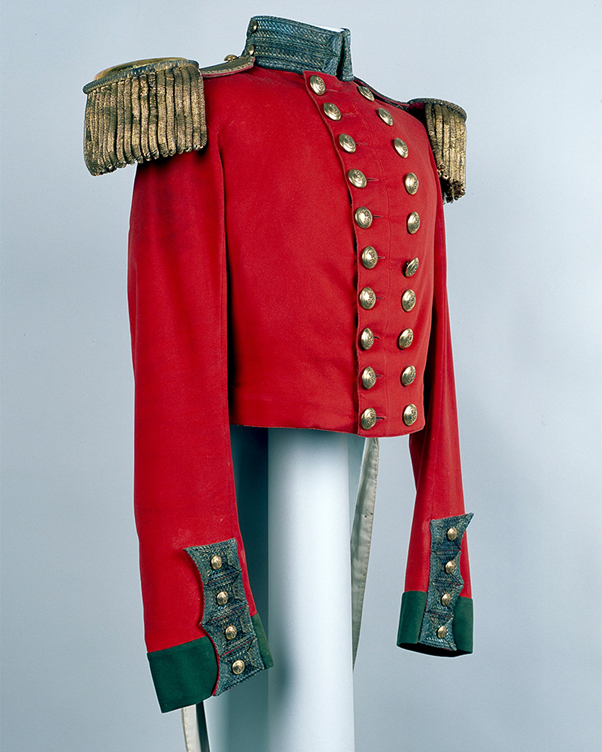
Dress Coatee of Major RB Baker, 39th (Dorsetshire) Regiment, 1854
Its final independent deployment was to India in 1869. It was still there in 1881, when it was merged with the 54th (West Norfolk) Regiment of Foot to form The Dorsetshire Regiment.
During the 19th century, battle honours were won in the Crimea War (1854-56), in India and Burma, as in the South Africa War
The epic of the SS Sarah Sands occurred when the Dorsets were en-route to India during the Mutiny of 1857; the officers and men of the regiment were primarily responsible for saving the blazing ship, filled with gunpowder, and bringing her eventually into Mauritius. A most complimentary Order was read at the head of every Regiment in the Army as a result, by order of the Commander-in-Chief.
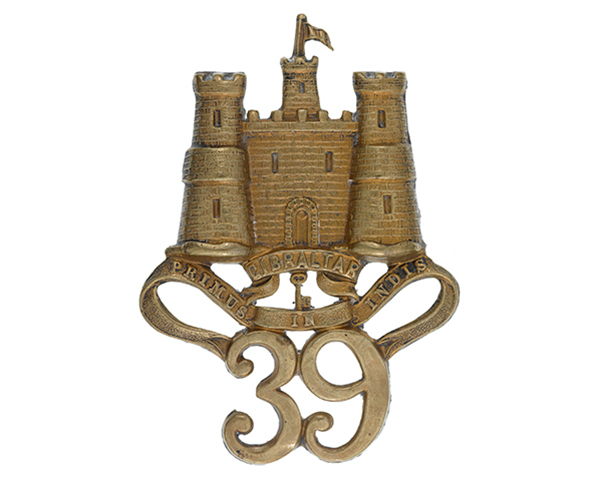
Glengarry Badge, 39th (Dorsetshire) Regiment of Foot, c1874
The 39th & 54th amalgamated in 1881 under the Cardwell Reforms, to become 1st & 2nd Battalions of the Dorset Regiment.
The Tirah Campaign of 1897, LCpl Vickery won the VC.
During the First World War, 10 battalions of the Dorset’s served in France and Flanders, in the Gallipoli Peninsula and in the Middle East. In Mesopotamia especially, the 2nd Battalion greatly distinguished itself as did the battalions on the Western Front.
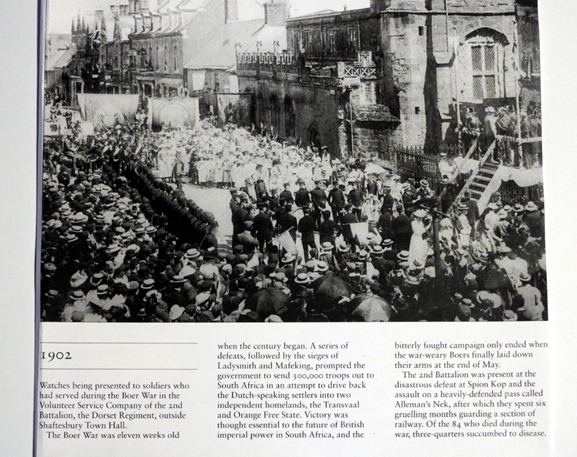 Presentation of Watches to service men back from The Boer War - at Shaftesbury Town Hall 1902
Presentation of Watches to service men back from The Boer War - at Shaftesbury Town Hall 1902
 Volunteers for the Dorset Regiment - outside The Crown, Marnhull, Dorset 1914
Volunteers for the Dorset Regiment - outside The Crown, Marnhull, Dorset 1914
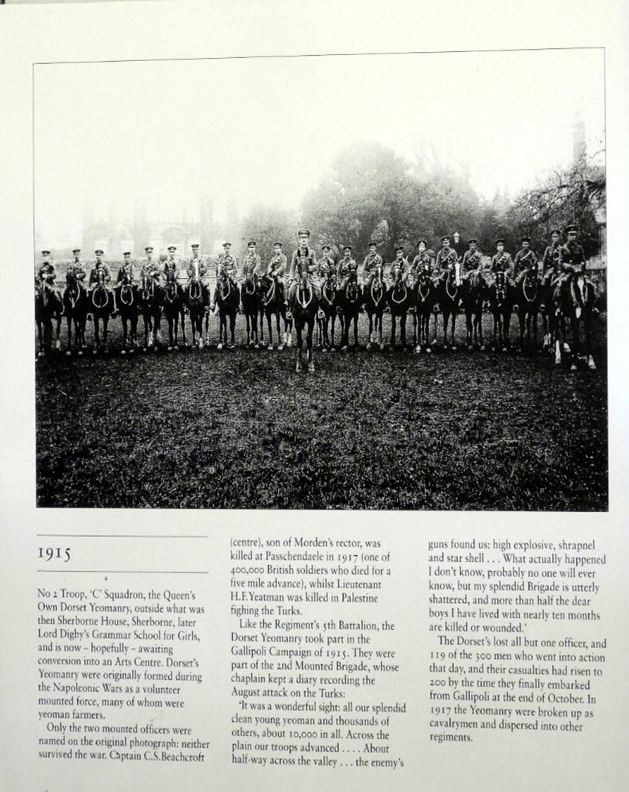 The Queen's Own Dorset Regiment, Sherborne House, Sherborne 1915
The Queen's Own Dorset Regiment, Sherborne House, Sherborne 1915
The English Battalion
It suffered such heavy casualties that in February 1916 it had to amalgamate with 2nd Battalion, The Norfolk Regiment to form the English Battalion, nicknamed 'the Norsets'. It was able to re-form as an independent battalion five months later, remaining in Mesopotamia until April 1918. It then moved to Egypt, Palestine and finally Syria.
Battles
SHAIBA Despatches 1915
Major General CJ Melliss' - Shaiba Despatch
Brigadier General C Fry - Shaiba Despatch
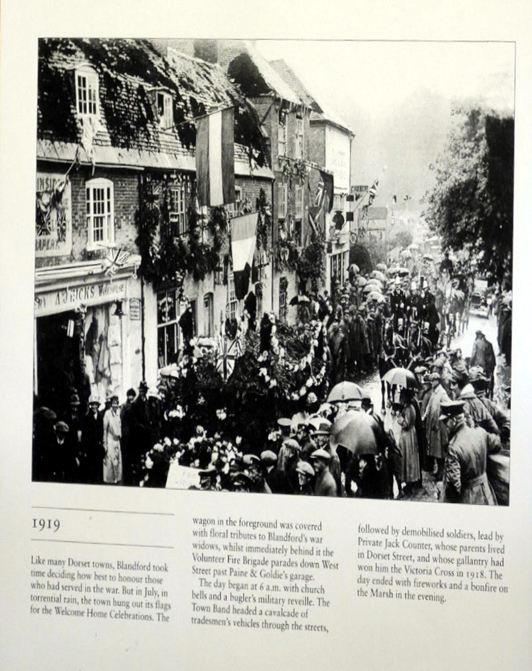
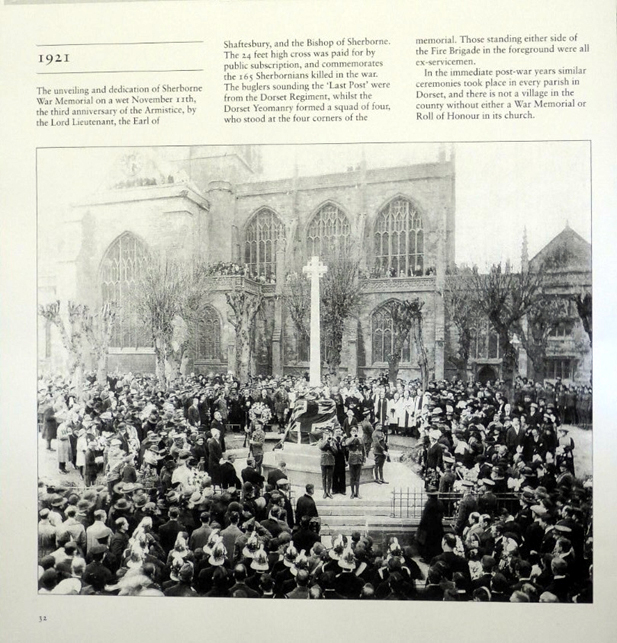
Unveiling and Dedication of Sherborne War Memorial 1921
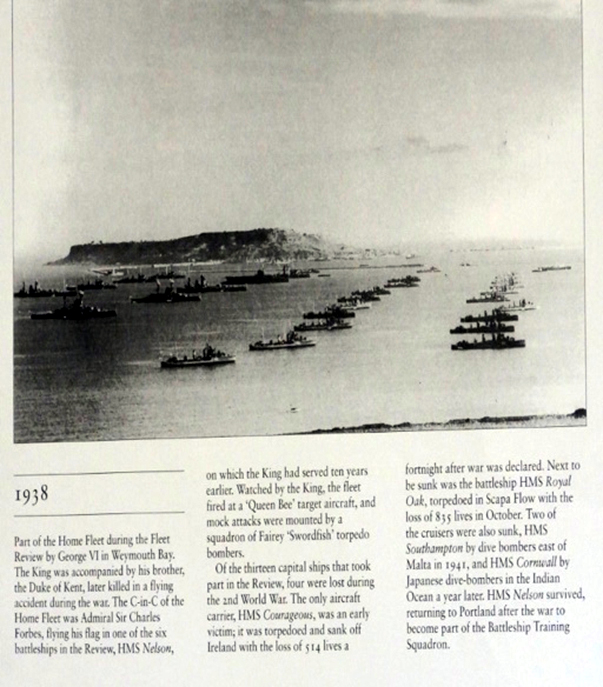
Weymouth Bay - Home Fleet Review by George VI 1938
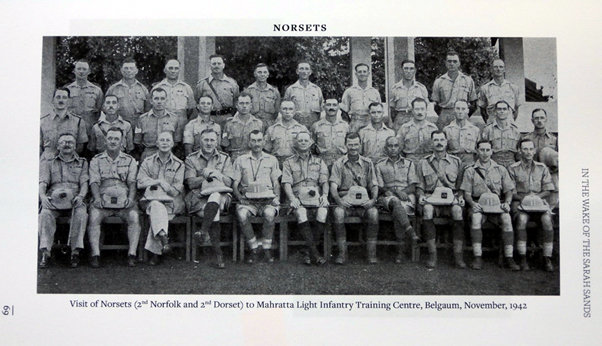
The Norsets November 1942
In the Second World War, the 1st Dorsets served in 231 (Malta) Brigade, taking part in assault landings on Sicily, Italy and at Normandy (D Day) while the 4th (TA) Battalion, which, with the 5th, formed part of the 43rd Wessex Division, sacrificed itself in going to the rescue of the Airborne troops at Arnhem. The 2nd Battalion served in Burma, including Kohima. For more information about this, including many photographs, please follow this link . Many of the images shown are from Lt Col O G W White DSO OBE's book 'Straight on for Tokyo'. This can be purchased via this link.
The Devonshire and Dorset Regiment (11th , 39th and 54th Foot) (1958 – 2007)
As part of the 1957 Defence Review, it was announced that there would be a reduction in the number of infantry battalions in the British Army. The reduction was to be effected by the merging of a number of pairs of regiments.
Among the mergers to be carried out were those of the regiments of the two neighbouring counties of Devon and Dorset.
• Devonshire Regiment (the former 11th Regiment of Foot, originally raised in 1685)
• Dorset Regiment (the successor to the 39th Foot, raised in 1702; and the 54th Foot, dating from 1755)
The amalgamation took place in Minden, Germany, on 17 May 1958. The new 1st Battalion, Devonshire and Dorset Regiment was commanded by Lieutenant-Colonel Guy Young, formerly commanding officer of the 1st Devonshires, while the colonel of the regiment was Major-General George Neville Wood, formerly of the Dorsets.
The amalgamation of these two famous old County Regiments took place in Celle in 1958 and the presentation of its first Stand of Colours by the then Colonel-in-Chief, HRH The Duchess of Kent in Plymouth in 1962. The new cap badge embodied the Castle of Exeter and ‘Semper Fidelis’ from the Devon’s, and ‘Primus in Indis’ and the Sphinx with ‘Marabout’ from the Dorset’s.
The Devonshire and Dorset Regiment Chapel is in Exeter Cathedral and the Dorset Regiment Chapel is in Sherborne Abbey.
The Regiment’s Museum is at The Keep in Dorchester
In November 1958 the 1st Battalion moved to Cyprus, where they carried out anti-insurgency activities against the paramilitary EOKA organisation. A ceasefire was called in December 1959, and the island achieved independence from Britain in August 1960. Following the ending of the conflict the battalion carried out exercises in Libya before returning to the United Kingdom in 1961.
From 1961 to 1963 the battalion was based in Plymouth, taking part in exercises on Salisbury Plain and in recruitment activities following the ending of National Service. In May 1962 the regiment was given the freedom of the City of Exeter, and were presented with a stand of colours by the Colonel-in-Chief, Princess Marina, Duchess of Kent.
From July 1963 the battalion was based in Holywood, County Down. Placed on twenty-four hours' travel notice, in May 1964 they moved to British Guiana where there was political and civil unrest. Elections were held in December of that year, a first step in the independence of the colony. The battalion returned to Holywood in January 1965.
In February 1966 the battalion joined the British Army of the Rhine (BAOR) as part of 6th Infantry Brigade based in Münster.
The old County TA battalions were disbanded in 1967.
In 1967 disturbances spread throughout the Arab world in the wake of the Six-Day War. The battalion were dispatched to Benghazi in Libya to evacuate isolated British personnel. In January 1968 the regiment were transferred within the BAOR to the 12th Infantry Brigade based in Osnabrück. In 1970 the battalion moved to Malta. Following the outbreak of The Troubles in Northern Ireland, the Devon and Dorsets were moved to Belfast with less than twenty four hours' notice in June 1970. They found themselves involved in the Battle of the Falls. They returned to Malta in August 1970.
In 1971 the battalion moved to Gordon Barracks in Gillingham, Kent. As an air-portable unit, elements of the Devon & Dorsets were frequently dispatched to various locations at short notice: In January 1972 they moved to County Armagh, to British Honduras in August 1972, to West Belfast in October 1973, to Cyprus in October 1974 and to Belize in November 1975.
In May 1976 the battalion rejoined the 12th Mechanised Brigade in Osnabrück. They did two tours of duty in Northern Ireland: in North Belfast from January to May 1977 and in Central Belfast from January to May 1979.
In April 1980 the battalion moved to Colchester. From July to November 1981 they did another tour in County Armagh under Operation Banner, and in 1982 took part in training exercises in Kenya.
In March 1983 the Devon & Dorsets became a resident battalion at Abercorn Barracks in Ballykinler in Northern Ireland as part of the 39th Infantry Brigade, remaining there until 1985. In 1985 they joined the Berlin Brigade, remaining in the city until 1987.
The Regiment’s Territorial Army Battalion, the 4th Battalion, was reformed in 1987, 20 years after disbandment of the old County TA battalions in 1967.
From February 1987 the battalion formed part of 1st Brigade at Bulford. Elements of the regiment were sent to the Falkland Islands and Belize in 1987 and 1988. From April to August1989 they did another tour of duty in County Armagh. The Regimental Band were sent to the Persian Gulf between October 1990 and March 1991 as part of Operation Granby to serve in a field hospital.
In 1991 this changed to an Armoured Infantry (Warrior) role in 1 (UK) Armoured Division, part of NATO’s Allied Rapid Reaction Corps. During this time the 1st Battalion had trained in Kenya, Canada, Sicily, Italy, and France.
In August 1991 the battalion returned to Germany and was based in Werl and Paderborn.
1993 they had another tour of duty in West Belfast.
In In 1994 they moved to Paderborn as part of the 20th Armoured Brigade, and in Poland where they were the first British troops to exercise on Polish soil since before the Second World War.
In May 1995 the battalion formed part of the United Nations Protection Force intervening in the Bosnian War. Corporal Simon Harvey was awarded the Military Cross for twice extracting his Warrior tracked armoured vehicle from enemy fire on the Mount Igman route into Sarajevo. For part of the campaign they served alongside the French 2e Régiment Étranger d'Infanterie as part of United Nations Task Force Alpha, and a bond of friendship was later established between the two units.
Dorset Yeomanry
In April 1997, the Dorset Yeomanry were raised again for the fourth time since 1794, exactly 30 years after the Queen’s Own Dorset Yeomanry were stood down.
The new regiment was unique in many ways- not least of which it was the only Territorial Regiment to be involved with both heavy and light armoured vehicles in use with the British Army, in it’s Armour Replacement role.
The Devon & Dorset battalion returned to Paderborn in November 1995 and was based there until 1998. Parts of the unit spent time in Fermanagh between December 1996 and June 1997. In March 1998 they moved to Warminster where they assumed responsibility for teaching infantry tactics at the Combined Arms Tactics Centre Battle Group.
The role in Germany for much of this time was that of a NATO Mechanised Battalion in 1 (BR) Corps.
The 4th Battalion whose Headquarters was in Exeter, had Rifle Companies in Plymouth, Dorchester and Poole, and Headquarter Company and Support Group in Exeter before being disbanded in 1999,
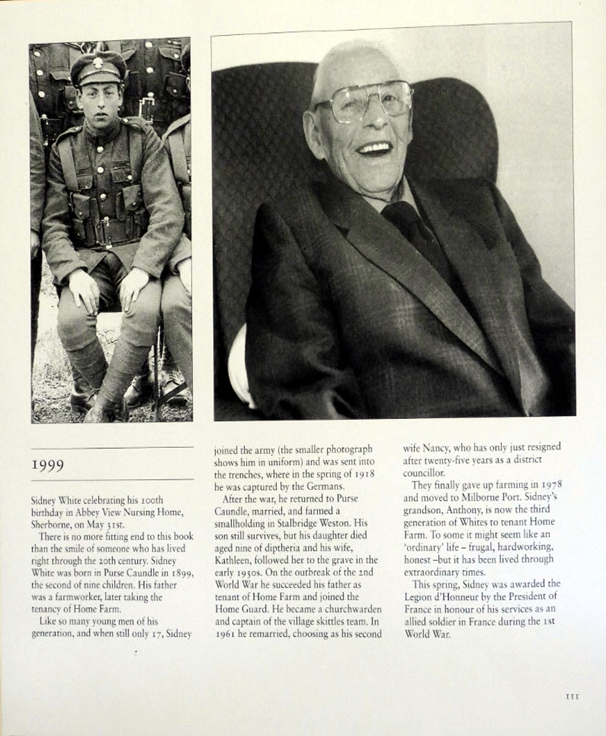 Sidney White - celebrating his 100th birthday in Sherborne 1999.
Sidney White - celebrating his 100th birthday in Sherborne 1999.
They moved to the Cavalry Barracks, Hounslow in 2000. After intensive training, the battalion performed public duties in London and Windsor which included providing the Queen's Guard at Buckingham Palace during the September 11 attacks and in 2002 attending the state funeral of Elizabeth, the Queen Mother.
The Devon and Dorsets was again the resident battalion at Ballykinler from 2002 to 2004. In 2004 the battalion moved to Catterick Garrison.
In 2003 a defence white paper, Delivering Security in a Changing World, was published. Among the changes proposed was the amalgamation of all single-battalion infantry regiments into multi-battalion large regiments. As a result, discussions were undertaken between The Light Infantry and the Devonshire and Dorset Regiment concerning the formation of a three-battalion regiment. In December 2004 details of the amalgamations to be carried out were announced at the Gillingham Branch Association dinner at the Hunters Lodge. The Devonshire and Dorset Regiment would integrate Gloucestershire elements of the Royal Gloucestershire, Berkshire and Wiltshire Regiment to form a new battalion of The Light Infantry. As part of the preparation for this, the regiment moved from the Prince of Wales' Division to the Light Division, and was renamed the Devonshire and Dorset Light Infantry, on 22 July 2005.
On 24 November 2005, the Ministry of Defence announced further changes to the amalgamations. The regiment were now to join a new large regiment created by the amalgamation of the Devonshire and Dorset Regiment, The Light Infantry, the Royal Gloucestershire, Berkshire and Wiltshire Regiment, and the Royal Green Jackets. This new regiment was to be called The Rifles.
During the 1st Battalion’s 49 years of existence, it has served in Germany, Cyprus, the UK, British Guiana (Guyana), Libya, Malta, British Honduras (Belize), Bosnia and Northern Ireland. Most of this service, including ten tours to Northern Ireland, two of which as a Resident Battalion, have been active service of one kind or another, the latest of which was to Iraq in 2006.
The Rifles and was formed in February 2007. In the lead-up to the formation of The Rifles, officers and men of all four regiments were cross posted, but 1st Battalion, The Rifles was formed from the regular battalions of the Devonshire and Dorset Regiment and the Royal Gloucestershire, Berkshire and Wiltshire Regiment. On becoming part of a rifle regiment, the Devon and Dorsets no longer carried their colours; these were laid up in Exeter Cathedral on 27 January 2007.
Regimental museum
The Devonshire and Dorset regimental collections are displayed in the Keep Military Museum, Dorchester.
Colonels-in-Chief
Colonels-in-Chief of the regiment were:
• 1958–1968: Princess Marina, Duchess of Kent, CI, GCVO, GBE
• 1977–2007: F.M. Prince Edward, Duke of Kent, KG, GCMG, GCVO, ADC
Regimental Colonels
Colonels of the regiment were:
• 1958–1962: Maj-Gen. George Neville Wood, CB, CBE, DSO, MC
• 1962–1967: Maj-Gen. Hugh Alastair Borradaile, CB, DSO
• 1967–1977: Brig. Alexander Edward Craven Bredin, DSO, MC
• 1977–1979: Gen. Sir Arthur John Archer, KCB, OBE
• 1979–1984: Col. Michael Frederick Robert Bullock, OBE, DL
• 1984–1990: Maj-Gen. Colin Terry Shortis, CB, CBE
• 1990–1998: Gen. Sir John Finlay Willasey Wilsey, GCB, CBE, ADC
• 1998–2002: Maj-Gen. Bryan Hawkins Dutton, CB, CBE
• 2002–2007: Lt-Gen. Sir Cedric Norman George Delves, KBE, DSO
• 2007: Regiment amalgamated with the Royal Gloucestershire, Berkshire and Wiltshire Light Infantry, The Light Infantry and the Royal Green Jackets to form The Rifles.
Alliances
![]() • Canada – Les Fusiliers de Sherbrooke
• Canada – Les Fusiliers de Sherbrooke![]() • Australia – The Royal New South Wales Regiment
• Australia – The Royal New South Wales Regiment![]() • Malaysia – 6th Battalion, Royal Malay Regiment
• Malaysia – 6th Battalion, Royal Malay Regiment![]() • South Africa – 5 South African Infantry Battalion (Bond of Friendship)
• South Africa – 5 South African Infantry Battalion (Bond of Friendship)![]() • United Kingdom Navy – HMS Exeter
• United Kingdom Navy – HMS Exeter![]() • France – 2e Régiment Étranger d'Infanterie (Bond of Friendship)
• France – 2e Régiment Étranger d'Infanterie (Bond of Friendship)
The Rifles Regiment
• Devonshire Regiment (1685–1958)
• 39th (Dorsetshire) Regiment of Foot (1719–1881)
• 54th (West Norfolk) Regiment of Foot (1755–1881)
• Somerset Light Infantry (1685–1959)
• 32nd (Cornwall) Regiment of Foot (1702–1881)
• 46th (South Devonshire) Regiment of Foot (1741–1881)
• 51st (2nd Yorkshire West Riding) Regiment of Foot (1755–1881)
• 105th Regiment of Foot (Madras Light Infantry) (1862–1881)
• 53rd (Shropshire) Regiment of Foot (1755–1881)
• 85th Regiment of Foot (Bucks Volunteers) (1793–1881)
• 68th (Durham) Regiment of Foot (Light Infantry) (1758–1881)
• 106th Regiment of Foot (Bombay Light Infantry) (1868–1881)
• 28th (North Gloucestershire) Regiment of Foot (1694–1881)
• 61st (South Gloucestershire) Regiment of Foot (1758–1881)
• 49th (Princess Charlotte of Wales's) (Hertfordshire) Regiment of Foot (1744–1881)
• 66th (Berkshire) Regiment of Foot (1758–1881)
• 62nd (Wiltshire) Regiment of Foot (1756–1881)
• 99th (Lanarkshire) Regiment of Foot (1824–1881)
• 43rd (Monmouthshire) Regiment of Foot (1741–1881)
• 52nd (Oxfordshire) Regiment of Foot (1755–1881)
• King's Royal Rifle Corps (1756–1966)
• Rifle Brigade (The Prince Consort's Own) (1802–1966)
• Dorset Regiment (1881–1958)
• Duke of Cornwall's Light Infantry (1881–1959)
• King's Own Yorkshire Light Infantry (1881–1968)
• King's Shropshire Light Infantry (1881–1968)
• Durham Light Infantry (1881–1968)
• Gloucestershire Regiment (1881–1994)
• Royal Berkshire Regiment (1881–1959)
• Wiltshire Regiment (1881–1959)
• Oxfordshire and Buckinghamshire Light Infantry (1881–1966)
• Devonshire and Dorset Regiment (1958–2007)
• Somerset and Cornwall Light Infantry (1959–1968)
• The Light Infantry (1968–2007)
• Royal Gloucestershire, Berkshire and Wiltshire Regiment (1994–2007)
• Duke of Edinburgh's Royal Regiment (1959–1994)
• Royal Green Jackets (1966–2007)
The Rifles was formed on 1st February 2007 from an amalgamation of four famous regiments:
The Devonshire and Dorset’s, the Royal Gloucestershire Berkshire and Wiltshire’s, the Light Infantry and the Royal Green Jackets. The new Regiment consists of 5 Regular and 2 Territorial Battalions.
1st Battalion is based at Chepstow and returned from operations in Afghanistan in April.
2nd Battalion based in Ballykinler, Northern Ireland and deployed to Afghanistan in April.
3rd Battalion is based in Edinburgh and is due to deploy to Afghanistan in the end of the year.
4th Battalion is based in Bulford near Salisbury and deploys to Afghanistan shortly to cover the elections there.
5th Battalion based in Paderborn, Germany is currently returning from a tour of duty in Iraq.
6th (Territorial) Battalion has its Headquarters in Exeter and bases throughout the Westcountry, including Dorchester. Over 100 of the Battalion’s soldiers have recently returned from Afghanistan.
7th (Territorial) Battalion has its Headquarters in Reading and bases throughout the Home Counties.
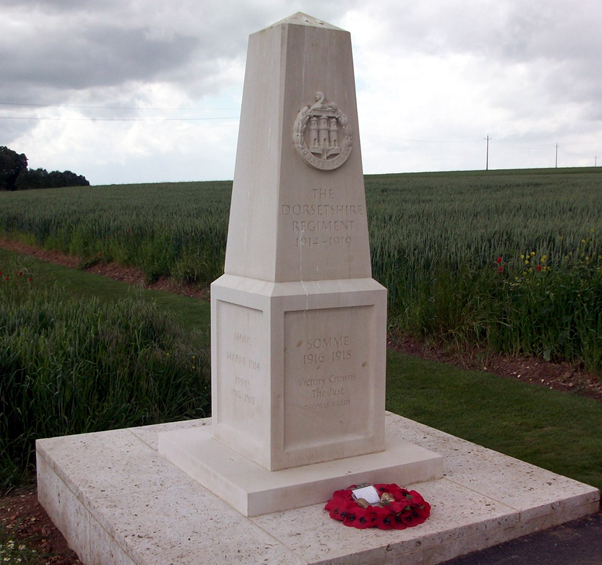

Members of The Rifles Killed in Action from 1st February 2007
